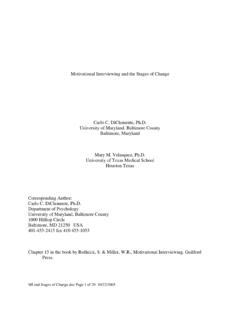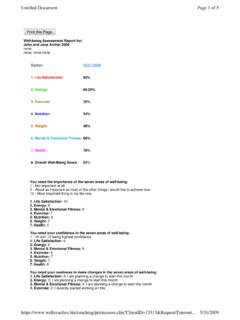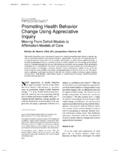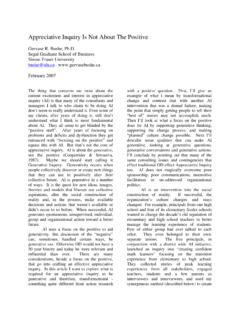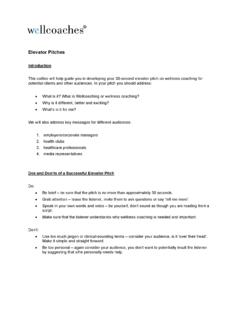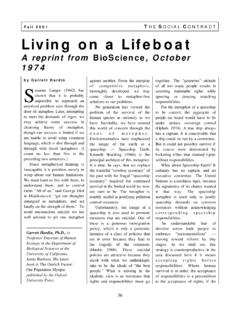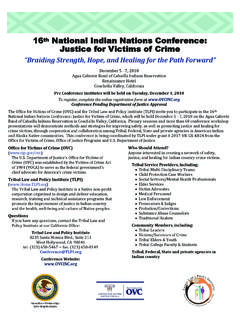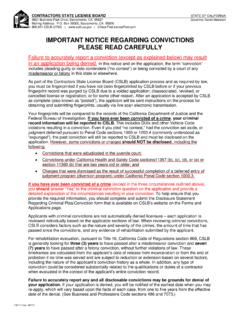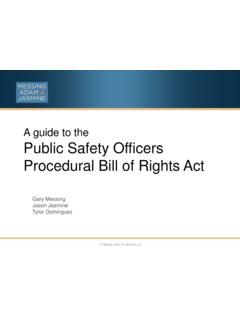Transcription of FastCompany.com | January 2007 | By
1 The Three Keys to Change In this excerpt from the introduction to his new book, Change or Die: The Three Keys to Change at Work and in Life, Alan Deutschman discusses the framework to successfully change yourself. From: | January 2007 | By: Alan Deutschman Change or die. What if you were given that choice? For real. What if it weren't just the hyperbolic rhetoric that conflates corporate performance with life or death? Not the overblown exhortations of a rabid boss, or a maniacal coach, or a slick motivational speaker, or a self-dramatizing chief executive officer or political leader. We're talking actual life and death now. Your own life and death. What if a well-informed, trusted authority figure said you had to make difficult and enduring changes in the way you think, feel, and act? If you didn't, your time would end soon--a lot sooner than it had to. Could you change when change really mattered? When it mattered most? Yes, you say? Try again. Yes?
2 You're probably deluding yourself. That's what the experts say. They say that you wouldn't change. Don't believe it? You want odds? Here are the odds that the experts are laying down, their scientifically studied odds: nine to one. That's nine to one against you. How do you like those odds? This revelation unnerved me when I heard it in November 2004 at a private conference at Rockefeller University, an elite medical research center in New York City. The event was hosted by the top executives at IBM, who invited the most brilliant thinkers they knew from around the world to come together for a day and propose solutions to some of the world's biggest problems. Their first topic was the crisis in health care, an industry that consumes an astonishing $ trillion a year in the United States alone--more than one seventh of the entire economy. Despite all that spending, we're not feeling healthier, and we aren't making enough progress toward preventing the illnesses that kill us, such as heart disease, stroke, and cancer.
3 A dream team of experts took the stage, and you might have expected them to proclaim that breathtaking advances in science and technology--mapping the human genome and all that--held the long- awaited answers. That's not what they said. Speaking to the small group of insiders, they were unsparingly candid. They said that the cause of the health care crisis hadn't changed for decades, and the medical establishment still couldn't figure out what to do about it. Dr. Raphael "Ray" Levey, founder of the Global Medical Forum, an annual summit meeting of leaders from every part of the health care system, told the audience: "A relatively small percentage of the population consumes the vast majority of the health care budget for diseases that are very well known and by and large behavioral." That is, they're sick because of how they choose to lead their lives, not because of factors beyond their control, such as the genes they were born with. Levey continued: "Even as far back as when I was in medical school"--he enrolled at Harvard in 1955--"many articles demonstrated that eighty percent of the health care budget was consumed by five behavioral issues.
4 " He didn't bother to name them, but you don't need an MD to guess what he was talking about: Too much smoking, drinking, and eating. Too much stress. Not enough exercise. Then the really shocking news was presented by Dr. Edward Miller, dean of the medical school and chief executive officer of the hospital at Johns Hopkins University. He talked about patients whose arteries are so clogged that any kind of exertion is terribly painful for them. It hurts too much to take a long walk. It hurts too much to make love. So surgeons have to implant pieces of plastic to prop open their arteries, or remove veins from their legs to stitch near the heart so the blood can bypass the blocked passages. The procedures are traumatic and expensive--they can cost more than $100,000. More than one and a half million people every year in the United States undergo coronary bypass graft or angioplasty surgery at a total price of around $60 billion. Although these surgeries are astonishing feats, they are no more than temporary fixes.
5 The operations relieve the 6 patients' pain, at least for a while, but only rarely--fewer than 3 percent of the cases--prevent the heart attacks they're heading toward or prolong their lives. The bypass grafts often clog up within a few years; the angioplasties, in only a few months. Knowing these grim statistics, doctors tell their patients: If you want to keep the pain from coming back, and if you don't want to have to repeat the surgery, and if you want to stop the course of your heart disease before it kills you, then you have to switch to a healthier lifestyle. You have to stop smoking, stop drinking, stop overeating, start exercising, and relieve your stress. But very few do. "If you look at people after coronary- artery bypass grafting two years later, ninety percent of them have not changed their lifestyle," Miller said. "And that's been studied over and over and over again. And so we're missing some link in there. Even though they know they have a very bad disease and they know they should change their lifestyle, for whatever reason, they can't.
6 ". That's been studied over and over and over again. The dean of the nation's most famous medical school said so with confidence. But following the conference, when I searched through the archives of the leading scientific journals, I came across something strange. Something that just didn't fit. In 1993, Dr. Dean Ornish, a professor of medicine at the University of California at San Francisco, convinced the Mutual of Omaha insurance company to pay for an unusual experiment. The researchers recruited 194 patients who suffered from severely clogged arteries and could have bypass grafts or angioplasties covered by their insurance plans. Instead they signed up for a trial. The staffers helped them quit smoking and switch to an extreme vegetarian diet that derived fewer than 10 percent of its calories from fat. In places like Omaha, they shifted from steaks and fries to brown rice and greens. The patients got together for group conversations twice a week, and they also took classes in meditation, relaxation, yoga, and aerobic exercise, which became parts of their daily routines.
7 The program lasted for only a year. After that, they were on their own. But three years from the start, the study found, 77 percent of the patients had stuck with these lifestyle changes--and safely avoided the need for heart surgery. They had halted--or, in many cases, reversed--the progress of their disease. If the medical establishment was resigned to the supposed fact that only one out of every ten people can change, even in a crisis, then how did Dr. Ornish's team inspire and motivate nearly eight out of ten of its heart patients to accomplish and sustain such dramatic transformations? In 2002 the Justice Department published a study that tracked 272,111 inmates after they were released from state prisons in fifteen states. This was the largest study of criminal recidivism ever conducted in the United States. The results were alarming: 30 percent of former inmates were rearrested within six months, and percent of them were rearrested within three years.
8 Most of the repeat offenders were felons. Psychologists and criminologists have come to share the belief that most criminals can't change their lives. Although a movement to "rehabilitate" offenders gained momentum in the sixties and seventies, the idea has since largely been abandoned. Now the experts believe that many criminals can't change because they're "psychopaths"--they're unlike the rest of humanity because they aren't burdened by conscience. They don't have any empathy for others. They're concerned only for themselves. In a word, they're ruthless. Psychopaths make up about 1 percent of the overall population, but they're thought to be the norm in prisons. A. large number of convicts have been put through "The Hare," the standard test for psychopathy, created by Dr. Robert Hare, a professor at the University of British Columbia, who has been an influential adviser to the Federal Bureau of Investigation. The average score for male inmates in North America is "moderately psychopathic.
9 " The experts admit that they really don't know what causes psychopathy. They assume that some people are simply born that way. They also believe that psychopaths can't change to be like the rest of us. This conclusion is powerful and convincing, but if you've lived for a while in San Francisco, you've probably come across a strange exception. On the waterfront, taking up an entire city block in an enviable location between the Bay Bridge and the Giants'. baseball stadium, there's what looks like a luxury condominium complex. The Delancey Street Foundation is actually a residence where criminals live and work together. Most of them have been labeled as "psychopaths.". They typically move to Delancey after committing felonies and having serious problems with addiction--to heroin or alcohol, most commonly. Judges send them to Delancey from the state prisons, where they belonged to gangs and perpetrated violence. They're usually the third generation of their families who have known only poverty, crime, and drug addiction.
10 They've never led lawful lives or even understood the values and ideals of lawful society. 7 They live at Delancey, five hundred of them, blacks and Latinos together with self- proclaimed neo- Nazis, along with only one professional staffer, Dr. Mimi Silbert, who earned PhDs in psychology and criminology before cofounding the program thirty- five years ago. Aside from Silbert, who's sixty- three and stands four feet, eleven and weighs about ninety- five pounds, the felons run the place themselves, without guards or supervisors of any kind. Delancey Street would sound crazy if it hadn't worked so brilliantly for so long. Silbert entrusts the residents-- remember, many of these people have been diagnosed as psychopaths--to care for and take responsibility for one another. They kick out anyone who uses drugs, drinks alcohol, or resorts to threats or violence. Although most of them are illiterate when they first arrive, the ex-cons help one another earn their high school equivalency degrees, and they all learn at least three marketable skills.

